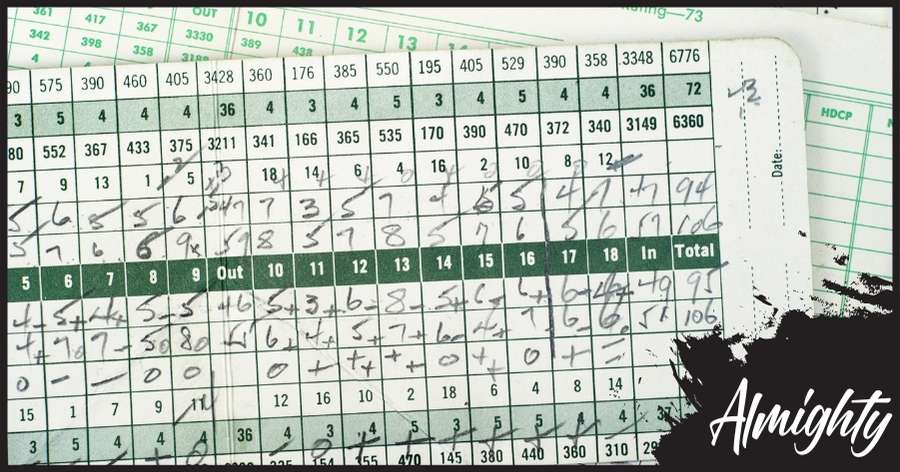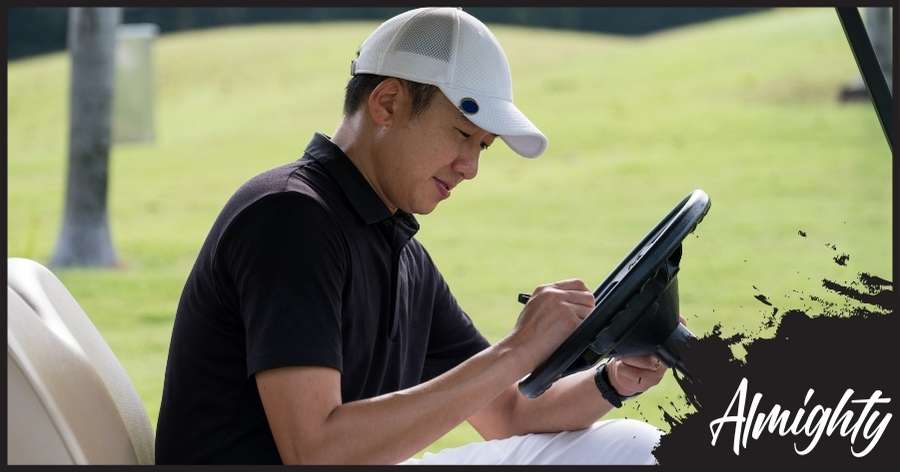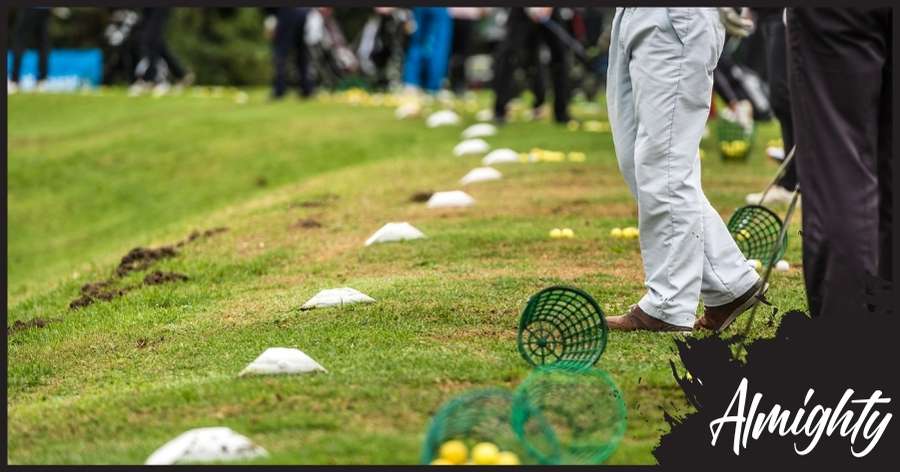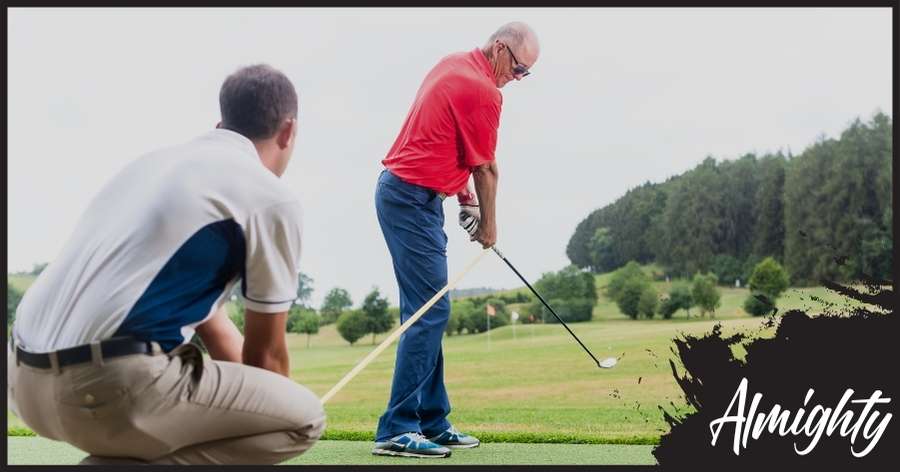
Every time you step onto the green, you might be wondering how your golf scores stack up against other golfers.
It’s a common question among beginners.
Always trying to gauge if they’re better than the “average golfer”.
I remember the first few times I played…
The club in hand, full of dreams and ambition, yet clueless about what a good score looked like for someone like me.
Was I shooting below or above the average for beginners?
It didn’t affect me too much because I was just focused on my game and trying to improve…
But as I got more and more competitive, and the more I played the game, this question lingered in my mind…
“What is the average golf score for beginners like me, and how do I stack up?”
… classic ego check.
Everyone I played golf with always said “Don’t worry about other people’s scores, just worry about your own”, and it’s true. It’s solid advice!
But I always wanted to know…
And I’m guessing that’s why you’re here because you want to know too.
In this article, I’ll jump into what constitutes an “average score” or “average round”.
We’ll explore the benchmarks that can help you understand whether you’re on the right track or if there’s room for improvement.
From discussing the average scores for 9 and 18 holes to providing tips on how to enhance your game, this guide is designed to shed light on your performance and set you on the path to becoming a better player on the golf course.
Let’s dive in!
What Is a Good Golf Score?
First things first…
Aiming to “break 100” (shooting below 100) over 18 holes, is considered a good score for a beginner.
In fact, it’s widely regarded as a decent benchmark, but don’t let that number be your only goal.
For most golfers starting, to go from a score of 132 to 99 in a matter of a few rounds, isn’t feasible.
So instead, I personally like to classify a good golf score as…
“a score that’s similar or better than the previous round, even if it’s just by 1 stroke“.
When you’re starting out, your score can take some massive swings.
From 123, down to 111, then back up to 131.
It’s more important to be consistent than trying to make “hero shots” to save your bogey.
This is the mindset I had…
My first time out on a full 18-hole round, I shot well over 130+.
It would have been more, but luckily the other golfers insisted we cap at “double par”. This means you move to the next hole once you have shot double par for that hole.
After that round, I had a clear and simple goal: do better than last time.
Sometimes, it was about managing one less stroke on a troublesome par 4, or finally getting par on that one hole that always seemed to get the best of me.
So, what’s a good score? It’s equal to or slightly better than your last round.
It’s about setting personal records, no matter how small, and continuously striving for improvement.
Whether it’s working on your putting, mastering your drive, or just making sure you can keep the ball on the fairway, every bit of progress brings you closer to what you can proudly call a good score.
What Is an Average Golf Score For Beginners?

When you’re first starting in golf, the whole scoring thing can seem like rocket science. Pars, bogeys, double bogeys, double pars, etc.
Even the handicap system can be a bit confusing.
Just to make this post easier to understand, I’ll refer to “golf score” as the score golfer’s overall score at the end of a par 72 course.
Whereas a golf handicap is a numerical value that takes in a lot more variables to calculate and it’s considered more of a “leveling” system, helping balance out games among golfers of various skill levels.
With that being said, the average score for a beginner is usually around 108 for an 18-hole course.
For 9 holes, you’re looking at a score of 54 – essentially aiming to hit less than six strokes per hole.
But why even care about these numbers?
As a beginner golfer, they’re not just numbers – they’re more like milestones.
Every round you play is an opportunity for you to shoot lower than your previous round and that’s progress.
If you’re always trying to shoot under 108, but your average is 120, you’ll be severely disappointed every time you leave the course.
What is the Average Score When You Play Your First Round?
As I mentioned before, the average score for beginners is usually around 108, but you can expect much higher when it’s your first round.
When I played my first round, I shot a 130. Again, this would have been a lot higher if we didn’t incorporate the “double par” rule.
It was demoralizing, to say the least.
But here’s the thing, should that have discouraged me? Absolutely not.
The journey towards a lower score became my mission, a challenge that I always considered every time I set foot on a course.
So don’t worry about your score when you first play a round. Just go out with your friends and enjoy the game.
I know a lot of amateur golfers who didn’t even write down their score for their first round or even remember what it was. Because, ultimately, it doesn’t matter.
Factors Affecting Average Golf Score
When you’re out golfing with your buddies, hanging out, having fun – that’s fine.
But if you really want to focus on getting better and improving your game, you really need to understand the factors that can really influence your score.
Practice Before The Round Starts

Warming up isn’t just for professional golfers prepping for the Masters – it’s crucial for a beginner or a seasoned golfer too.
Think of it this way…
PGA professionals start their routine 2-3 hours before their tee time. They eat, stretch, workout, and then they start working on their game; pitch shots, chip shots, putting, then they hit the range and go through their golf drills using various golf clubs.
Do you really think you can just wake up, drive to the course, pull up to the first tee box, and shoot below or around 100?
Course Knowledge
Every course has its quirks, its “personality” if you will.
They each have their own unique set of hazards, trees, fairway bunkers, bunkers near the green, water hazards, etc., the list can go on.
Knowing where those hazards are can help you decide if you should play it safe, or make a hero shot.
When I started out, I would only play on one golf course – it was the nearest one and it was cheap.
But it was also challenging. It was long, had a great mix of par 3s, 4s, and 5s, and it allowed me to internalize the course and its different traps.
This knowledge helped me lower my score because I knew what club to use and when to attack the green.
If I chose a new course and didn’t have that internal knowledge, I’d use a golf app that has a GPS and map built in.
I’d review the course beforehand, as well as review the hole before teeing up.
Proper Equipment
Now I don’t mean getting the latest and greatest clubs on the market. Trust me, it’s not about being flashy, at least not when you’re starting out.
It’s about getting the right clubs.
Sure you can get second-hand clubs or hand-me-downs (I actually recommend both since they’re both economically friendly), but just make sure the person you’re getting the clubs from is roughly the same height as you.
Imagine getting a set of used clubs from someone that’s 5’6″, when you’re 6’2″ – this won’t work.
You’d have to adjust your stance and your swing just to make contact with the golf ball.
Additionally, you want to make sure the set is complete; driver, fairway woods, irons, wedges, and a putter.
I remember my set didn’t have a set of wedges. Instead, I would use my 9-iron, with various strengths and swings (1/4 swing, half swing, 3/4 swing), to cover the distances – I don’t recommend this.
Once I got my hands on some proper wedges, that reduced my score significantly.
Tips to Improve Your Average Golf Score
Here are 5 ways to improve your golf game and start reducing the number of strokes to complete the hole.
Take Lessons From A Golf Pro

I once thought taking lessons from a golf pro meant that I couldn’t do it myself. It was like admitting defeat.
There were a few reasons why I didn’t consider taking lessons.
First, I knew deep down that I could learn it – it was just a matter of time.
Secondly, taking lessons meant that I couldn’t do it myself – didn’t want to bruise my ego.
Lastly, it was the cost. I didn’t want to spend any more money on golf because I figured, I could just learn as I played.
All these thoughts, while valid, hindered my progress.
Getting professional help meant that I could fast-track my way to a lower score and lower handicap.
They’ve seen it all – the good, the bad, and the ugly swings. They can even provide tailor-made advice that YouTube videos can’t.
And regarding the cost, I did the math.
One lesson in my area was about $40/hour. One round of golf was also $40 (depending on the season’s peak periods).
That one lesson taught me so much more than one round of golf.
Trust me, it’s an investment that pays dividends in the long run.
If you want to read more, I created a post on how golf lessons are worth it.
Practice Regularly
Practicing doesn’t mean going to the driving range and hitting the ball willy-nilly – I learned this the hard way.
At first, I thought hitting the golf ball as far as possible was the way to get better.
Sure, it kind of helped with my ball striking, but I would go through 2 buckets without actually learning anything. And it didn’t translate well on the course.
Instead, it’s about deliberate practice.
This means focusing on your weaknesses and “dialing it in” until you become confident in it.
Whether it’s your swing, your putt, or chip shots – make it a point to practice deliberately and regularly. Sporadic practice won’t cut it.
Focus on Short Game
I’m sure you’ve heard of the saying “drive for show, putt for dough”.
I can’t tell you how many times I missed breaking 100, or even 90, because I couldn’t drain a 4-ft putt, or I couldn’t chip when I was on the fringe of the green, or when I was 50-yards out and instead of a simple pitch shot, I would shank it.
Based on Dave Pelz’s Short Game Bible, “60% to 65% of all golf shots occur inside 100 yards of the hole“, meaning that the short game accounts for the majority of shots in a round.
In fact, the majority of experienced golfers practice spend more time on short shots than long shots.
Focusing on your short game, especially on putting and chipping, is a surefire way to drop that score under 100.
Play with Better Players
There’s something about playing with golfers who are out of your league that can dramatically lift your game.
And it’s not just about trying to swing harder to keep up. It’s about watching how they approach a hole, their pre-shot routine, and their shot selection.
Trust me, although it feels comfortable to play with people at your skill level, this approach never leads to growth and it’s mainly because you can’t ask each other for tips. It’s like asking the blind to lead the blind.
It can be intimidating, no doubt about it. It feels like they’re dissecting your golf swing, your second-hand clubs, or even the golf balls you’re using.
But, it was in this discomfort that I found my greatest strides in improvement.
Each round with better players was a lesson in humility.
I would ask them questions, feedback, and suggestions.
They push you to raise your game, to think smarter, and to refine your skills. It’s an invaluable experience.
Memorize Your Club Distances
Knowing my club distances was the single most important piece of information that transformed my game.
At first, I had a vague idea but nothing concrete.
I would check my rangefinder and think “I’m about 100 yards to the pin, I think that’s a pitching wedge”. Then I’d proceed to watch my ball soar past the flag.
Classic!
Take the time to learn how far you hit with each club. This isn’t just about raw power; it’s precision.
Understanding the exact distance I could hit with each club transformed my approach.
It’s the difference between guessing and knowing, and it’ll decide whether you’re on the green, in the sand, or visiting someone’s backyard.
Frequently Asked Questions
What’s a Good Beginner’s Golf Score for 9 Holes?
If you’re just getting your feet wet in the world of birdies and bogeys, a good 9-hole score for new golfers would be around 50-54. This would put you in the vicinity of 100-108 for a full 18, par 72, course.
This means if you manage to play each hole with just one stroke over par (aka a bogey), you’re right on track.
If you’re brand new to the game, expect a much higher score, somewhere around 120-130. Even that score is considered good.
What is an Average Golf Score for 9 Holes?
This one’s a bit tricky because “average” can vary widely based on who’s swinging the clubs.
For the average weekend warrior, scores can hover around the 45-47 mark.
Again, this depends on many factors like the course’s difficulty, weather conditions (because nobody likes playing in a mini-tornado), and, honestly, how lucky you’re feeling that day.
Final Thoughts On The Average Golf Score For Beginners
Look, at the end of the day, averages are just that – they’re averages.
They’re numbers that are lumped together and consist of players who golf once-a-year, and the avid “golf tournament novice” trying to break par.
It’s great to know, but ultimately it’s nothing to concern yourself over, especially if you’re just starting out.
Instead, take your last score and use that to serve as a measure of progress.
The world of golf is already tough to begin with. And having a great round is based on factors that you can control. Knowing the “average” score isn’t one of those factors.
Instead, devote your energy towards playing your best, and trust me, your game will improve over time.
before You Go…
As I mentioned before, improving your short game will drastically shave off some strokes from your scorecard.
In fact, this is one of the key elements that I changed in my game that allowed me to break 90 in 6 months.
That’s why I created two posts that talk about my favorite wedges, the 52 and 60 degree wedges.
Check it out:
